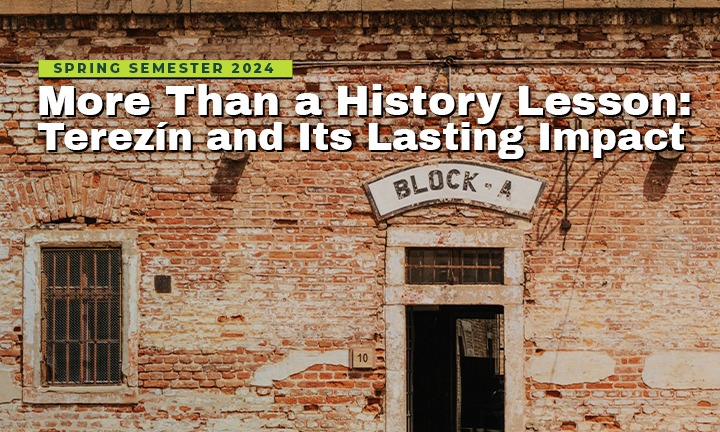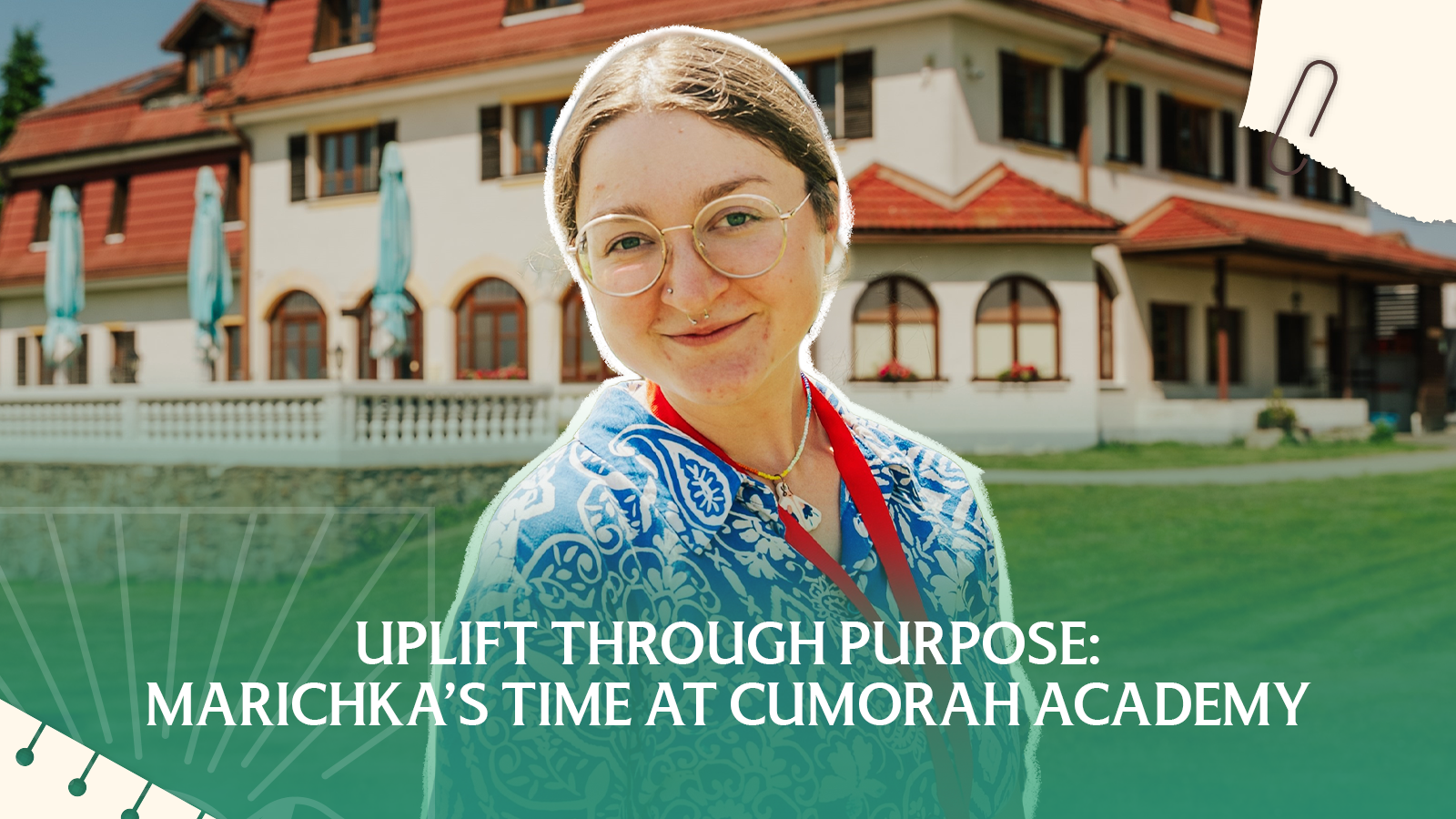The students at Cumorah recently went on a trip to Terezín in the Czech Republic. Terezín is the only concentration camp in the Czech Republic. It is hard to talk about. While I’m grateful we went, and for what I learned while being there, it is an emotional and profound topic to blog about. Because of this, I didn’t want to make this blog post in the third person. It feels too impersonal to do that.
To honor the gravity of the visit, I am going to insert my personal experiences as well. When I am writing as the Content Creator for Cumorah Academy I will keep the text normal, but when I switch to the first person and write as Mack, I am going to italicize the font.
I know this is a heavy and sensitive topic, but it was good to experience it. Let’s start the blog.
What is Terezín?
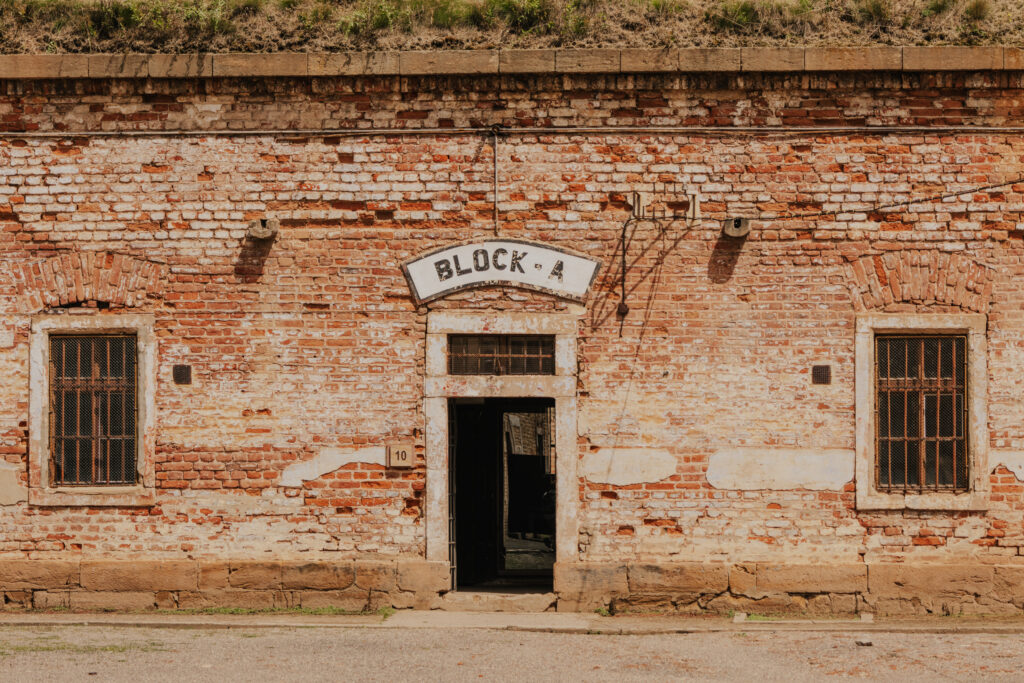
Terezín is a town located 90 miles north of Prague. It was originally built in the late 18th century as a military garrison town, as a means to protect Prague from the Prussian army. However, its history took a dark turn during World War II.
In 1940, Nazi Germany seized Terezín and transformed it into a concentration camp and ghetto. Initially intended for Jews from Czechoslovakia, Terezín soon became a holding ground for Jews from across Europe.154,000 people, including 15,000 children, were imprisoned there.
Today Terezín is a quiet town with about 2,900 residents, existing alongside a significant memorial site and ghetto museum dedicated to the horrors that unfolded there during World War II.
When you go to Terezín there are two parts. One part is the small fortress which was the “concentration camp” part/a prison for prominent Jews and Czech political figures. The rest of the town served as a ghetto, a forced community for Jews living in cramped and harsh conditions.
Unlike death camps, ghettos weren’t designed for immediate extermination, but residents still faced violence and restricted movement. This distinction was a Nazi fabrication. The “model ghetto” facade aimed to hide the true suffering within Terezín.
We first toured the Small Fortress, which is still standing, and then visited a museum that had some things left from the town when it functioned as a ghetto.
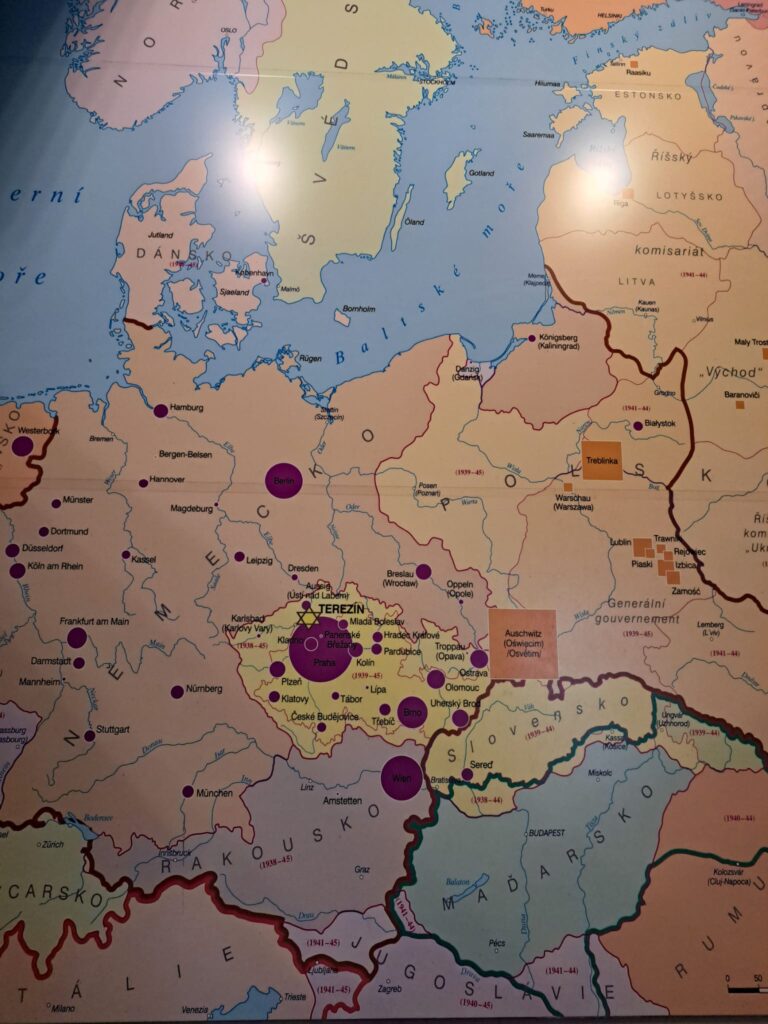
History of Terezín
During World War II, small bits of information about the treatment of the Jews reached the unbelieving and shocked outside world. The Nazis started to get increased pressure from outsiders about what was happening with the Jews.
To deflect this scrutiny, they created a deceptive solution – the “model ghetto” of Terezín, or as the Germans called it, “Theresienstadt.”
Theresienstadt
By 1941, the situation for Jews in Czechoslovakia was grim. Deportations of Jews to concentration camps had already begun, and the community felt the sting of loss.
According to this article, “The Nazis were facing two dilemmas. The first dilemma was what to do with the prominent Jews who were being carefully watched and looked after. Since most Jews were sent on transports under the pretension of work, the second dilemma was how the Nazis could peacefully transport the elderly Jewish generation.”
Terezín was once a bustling military community, but by the 1940s, it was a quiet, nearly isolated outpost. The Nazis saw an opportunity: transform this town into a supposed haven for Jews, all while concealing their true objective – mass extermination.
Under Nazi rule, Terezín served three purposes:
- Propaganda Tool: Terezín served as a cynical attempt by the Nazis to deflect international criticism of their treatment of Jews. By portraying it as a “model ghetto” with cultural activities and a seemingly normal life, they aimed to downplay the horrors of the Holocaust.
- Transit Camp: Terezín wasn’t a final destination for most Jews. It functioned as a holding pen where people were concentrated before being sent to extermination camps in occupied Poland, like Auschwitz.
- Exploitation: Terezín served as a source of forced labor for the Nazis. Jewish prisoners were used for various tasks within the camp, benefiting the Nazis and contributing to the deceptive facade of a normal life.
How Many People Were Imprisoned at Terezín?
154,000 people were imprisoned at Terezín. Of that, 88,000 people were deported to other concentration camps, (usually Auschwitz,) and 33,000 people died because of disease or malnutrition.
Nicolas, a Cumorah student from Brazil said, “As soon as we arrived at Terezín, there was a cemetery with the names, numbers, and dates of the people who died there. After crossing the field and arriving at the concentration camp, the guide explained to us what happened in each room. It was very sad and interesting to see how the things we learn in history books happened in real life, to see where people were tortured, and to get a sense of the precarious conditions in which they lived. It made me feel more empathy for the relatives of these people.”
Arriving at Terezín
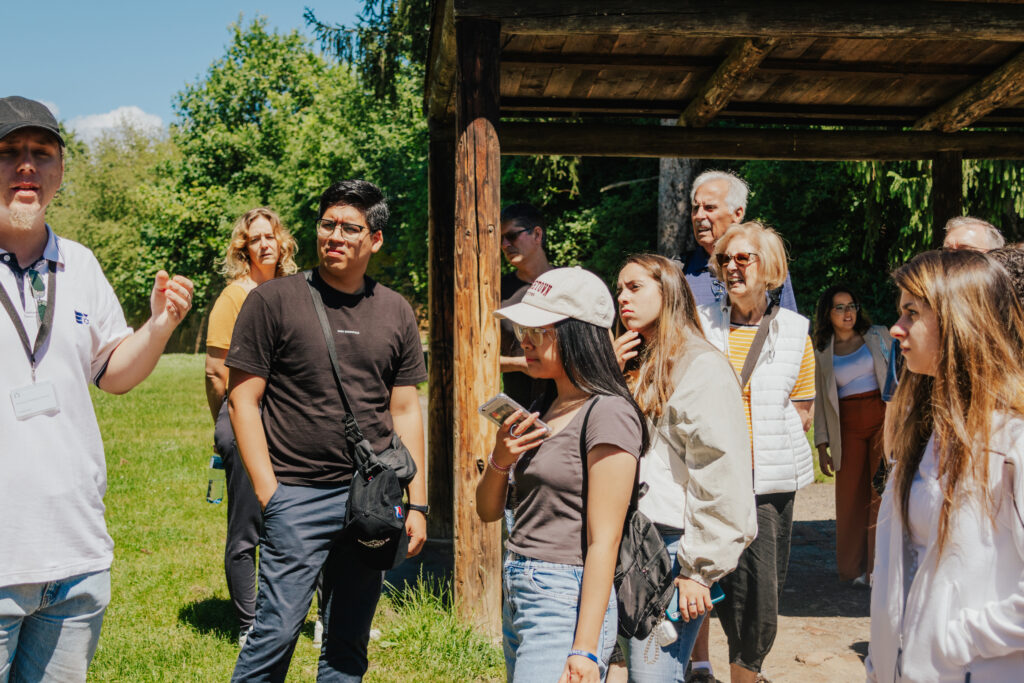
After walking past the rows of graves the students split into two groups, each led by a different tour guide, and toured the Small Fortress.
This part of the blog is hard for me to write. “Ironic” seems too weak of a word, but everything felt like an ironic slap in the face. It was all a show, a facade. A lot of Terezín was fake- putting on a show to the outside world to hide the horrors really going on. Above the entrance to the Small Fortress, there’s a sign that says, “ARBEIT MACHT FREI” which is German for “work makes you free.” We first went into one cell that was the size of a small bedroom, with only one small hole for a window. I actually thought “Oh, this is pretty big for a prison cell,” until our tour guide said they would put 60-90 prisoners in there. Other cells were much smaller. Some had no windows at all.”
The Small Fortress is small (population-wise) compared to the ghetto. It primarily housed prominent Jews, Czech resistance fighters, and political prisoners. It was designed for mass imprisonment, punishment, and extermination.
The small fortress is full of cramped prison cells, where many prisoners were placed, naked, without food and water, and in total darkness for days on end. A guard would ring a morning bell every day and prisoners would be put to work in the fortress or out in the ghetto.
Hunger gnawed at the prisoners in Terezín, both in the ghetto and Small Fortress. Food rations were scarce and of poor quality, leading to widespread malnutrition and a constant battle for survival. Compounding the ever-present hunger in Terezín was the rampant spread of disease. The cramped quarters, coupled with the lack of sanitation facilities and clean water, created a breeding ground for illness.
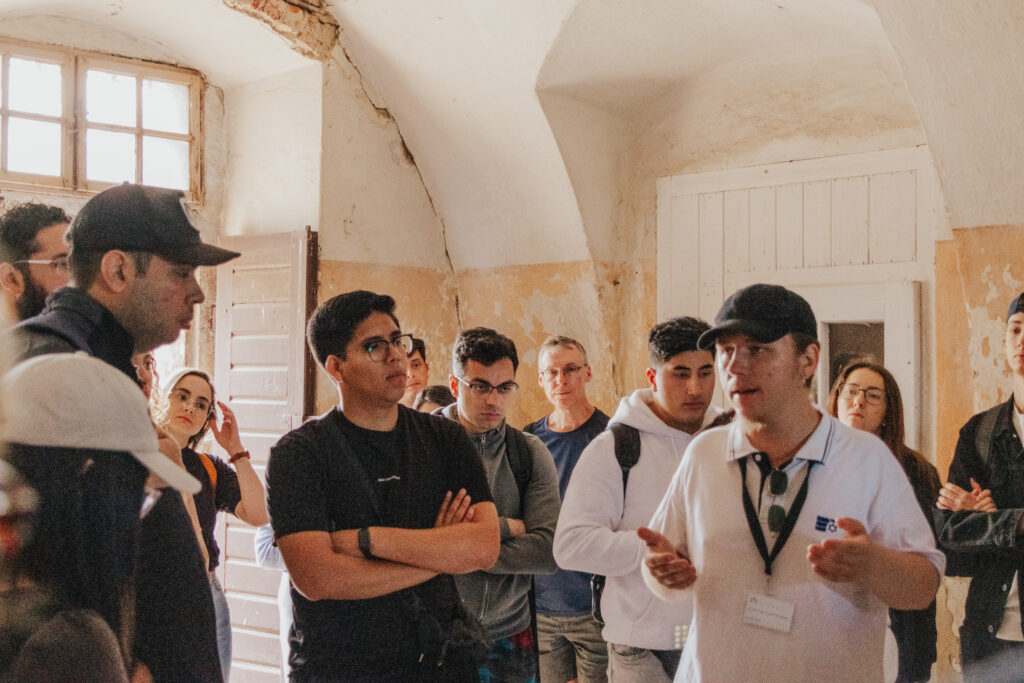
Diseases like typhus, dysentery, and tuberculosis spread quickly, further weakening the already malnourished prisoners. Medical care was scarce and often ineffective, leaving many to succumb to these illnesses. The constant threat of disease added another layer of fear and despair to the already horrific existence within the walls of Terezín.
Disease thrived in the damp darkness, fueled by a lack of sanitation and the scarcity of water. A single toilet and sink served a multitude of prisoners, highlighting the constant struggle for basic necessities. Artificial light was a rare privilege, leaving the prisoners to endure long stretches in a suffocating darkness.
In the first cell we went in, there was a bird’s nest in the corner of the ceiling. It was a poignant moment for me, to see that bird’s nest. When someone pointed the nest out our tour guide said “I guess that’s good. Something happy is happening in this place for once.”
I don’t know exactly how to explain the impact of the bird’s nest. Here I thought I was good with words, and yet, I have no idea how to describe how I felt at Terezín. It was a horrific place. The things that happened there were inhumane and I couldn’t believe it. The bird’s nest was a glimmer of hope. A defiant act of God and nature persisting in the face of human cruelty.
After leaving Terezín I looked up some articles about it. One article was written by someone who also saw bird’s nests and swallows while visiting Terezín.
In that article, the author said, “ I think daily of these birds and what I hope is their role on this sad planet. I hope they are angels, with their wings wiping away the tears of those who were murdered here. It’s a trite and sentimental thought…There’s a fierceness behind it that must be covered up, because alongside my ferocity is its companion: the longing to swaddle, too, to wrap up in soft white cloths and soft songs and prayers and offer love. And the birds seem to offer both. Claws and beaks, as well as feathers and wings.
Ghetto Life
After touring the Small Fortress the students went to the ghetto museum. The ghetto isn’t functioning anymore, however, the museum stands as a guardian of memory, preserving artifacts and stories from that dark chapter in history. Here, we would delve deeper into the lived experiences of those who endured the Terezín ghetto.
The ghetto was the rest of Terezín, apart from the Small Fortress. (The ghetto didn’t have any cells or torture chambers, like the Fortress, but Jews there lived in similar conditions, with a greater population.)
The Nazis portrayed it as a “model ghetto” for propaganda purposes. Over 60,000 Jews were forced to live here, in a space made for 7,000.
To quote one article, “The housing was separated by sex. Women and children under twelve were separated from the men and the boys over age twelve. Food was also a problem. In the beginning, there weren’t even enough cauldrons to cook food for all of the inhabitants. In May 1942, rationing with differential treatment to different segments of society was established. Ghetto inhabitants who worked at hard labor received the most food while the elderly received the least. The food scarcity affected the elderly the most. Lack of nourishment, lack of medicines, and general susceptibility to illness made their fatality rate extremely high.”
Every day was a struggle. Residents were forced to work. Food rations were barely enough to survive, often spoiled and insufficient. The constant fear of deportation to extermination camps like Auschwitz loomed large. News of these transports would filter back into the ghetto, adding to the despair. Life in the ghetto was a relentless battle for survival, with little hope for a brighter future. Harsh and overcrowded, with cramped living spaces, lack of sanitation, and meager food rations. Disease was rampant.
Triple-tiered bunk beds were used for people to sleep on, everyone got an estimated 2 yards of space to themselves. Sleeping conditions would have been uncomfortable and stressful. Little privacy, poor ventilation, and constant close contact with others would have been the norm. They started with thin mattresses on the beds but quickly got rid of them- as they brought fleas, lice, and other bugs.
Another student from Cumorah, Catarina from Brazil said, “My experience was very interesting. Seeing all those hard things and knowing that many innocent people suffered was humbling.”
It rained earlier in the day when we went to Terezín. While we were touring the Small Fortress we left one building with 30 cells in it, and there was a puddle outside. I sidestepped while walking out of the building so that I wouldn’t get my shoes wet. Then I stood and watched the rest of my group sidestep out of the building as well.
That was another profound moment for me. I felt very humbled. Here people had suffered horrific things, and I was worried about stepping into a puddle. I think I take for granted how many things I have and how blessed I am. A lot of my problems are mere puddles compared to the struggles some people go through. One big thing I felt at Terezín was empathy. More empathy and understanding for people who struggle. I’m grateful we went. It was hard and horrific, but it opened my heart up more and was important.
Propaganda
I’ve been putting off writing this section. It was a tragic part of the history of Terezín. I was shocked to hear about it, and it has been hard to continue my research about it.
In 2943 Danish Jews came to Terezín. This prompted inquiries from the Danish and Swedish Red Cross about their well-being. If the Jews were being taken care of. The Nazis decided to use Terezín as a propaganda tool, allowing a visit from the Red Cross to a single, carefully prepped location. Terezín was far from ready for such a visit.
The Nazis launched “The Embellishment,” a monstrous project to transform the camp for a day. Buildings were spruced up, fake shops created, and a playground even materialized. A pool was built. A sign saying “Boys’ School” was hung on a building. Another sign, saying “Closed for the holidays.” No one actually attended that school. They beautified the town and planned the Red Cross’s route carefully so they would see only the facade of the town the Nazis made.
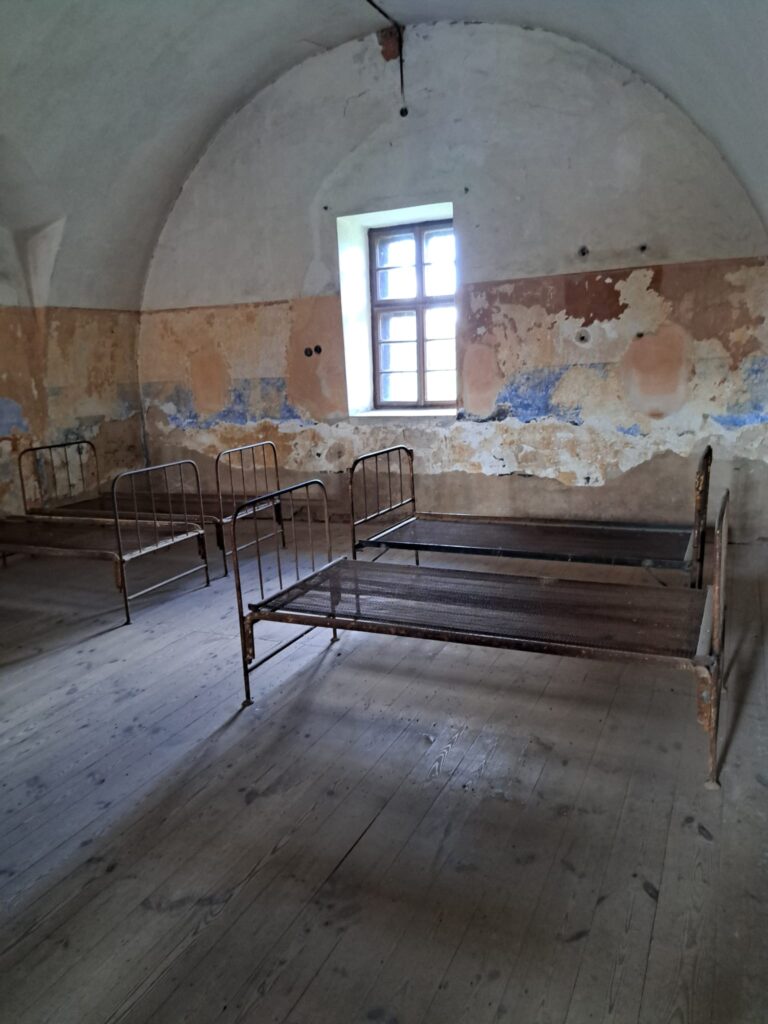
Most disturbingly, Terezín was too crowded for their liking. They deported 7,500 Jews right before the Red Cross came. The deported Jews were sick or orphans, and that would mess up the image of Terezín.
June 23, 1944, was the Red Cross visit. The Nazis had staged the whole day. They had people baking bread, a load of fresh vegetables being delivered, and workers singing. Messengers would come to tell people right before the Red Cross arrived so they could act. The whole thing was a facade, staged by the Nazis.
After their success with the Red Cross, the Nazis made a full-blown propaganda video of Terezín. It portrayed the ghetto as an idyllic “spa town” for Jews. This film, a cruel mockery of reality, aimed to deceive the world about the true fate of European Jews.
The film showcased scenes of happy and well-fed residents enjoying cultural events, sporting activities, and hanging out with everyone. This fantasy world stood in stark contrast to the reality of Terezín – a place of overcrowding, disease, and starvation.
The film’s cast and crew were all ghetto prisoners themselves, forced to participate in this twisted production under SS supervision. The cast, director, and anyone who was in the video was sent to Auschwitz and gassed upon arrival because they “knew too much.”
You can read more about that here and watch fragments of the propaganda video here.
It was heartbreaking. Everything was staged. Like I said earlier, the word “Ironic” doesn’t seem to quite fit. It feels weak. Not enough.
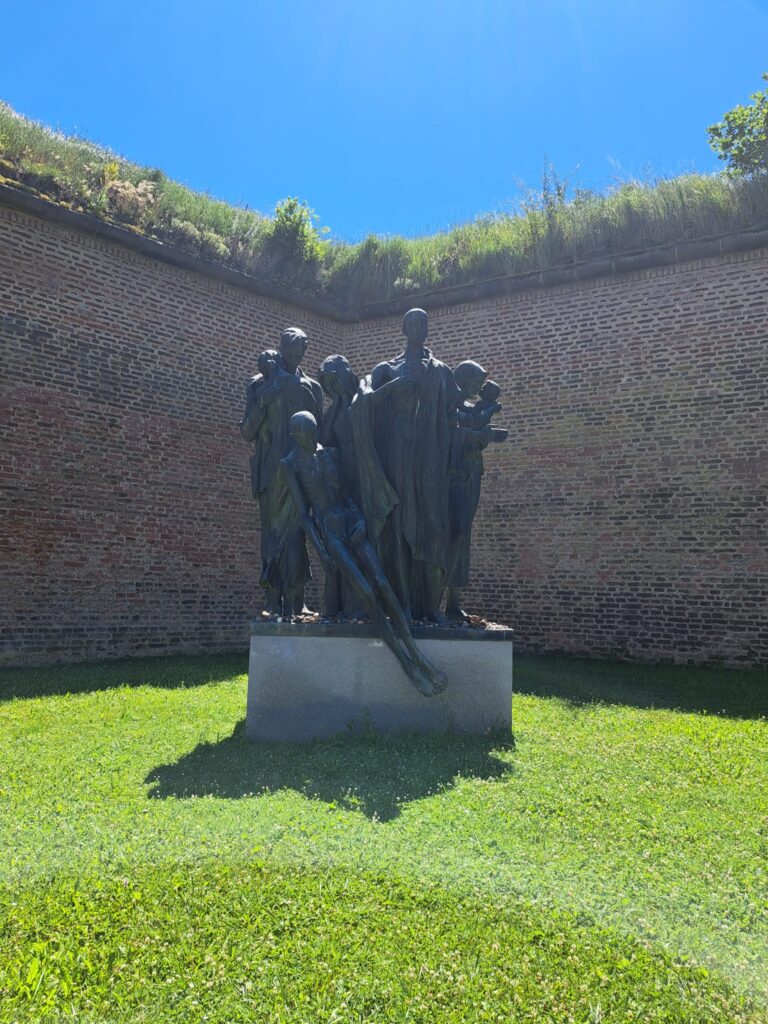
Death
Initially, Terezín buried its dead in traditional graves. (We passed them before touring the Small Fortress.) However, disease, starvation, and overcrowding quickly overwhelmed this system.
By September 1942, a crematorium was built to handle the growing number of corpses – not a gas chamber, but a solution to the dead bodies.
The Nazis would search the ashes for melted gold from teeth. When the war was nearing its end, they attempted to hide their crimes by dumping thousands of ash-filled boxes in a pit and a river.
Deports to Auschwitz
Life in Terezín wasn’t just about cramped living and constant hunger. A constant fear hung heavy in the air – the fear of deportation. While disease and starvation took their toll, the ultimate fate for most residents was transport to extermination camps like Auschwitz.
News of these transports filtered back into Terezín, adding to the despair. Selection for deportation became a terrifying lottery, tearing families apart and shattering any remaining hope.
Out of the 154,000 people imprisoned at Terezín, 88,000 of them were deported to other concentration camps.
Ghetto Museum
If you ever go visit Terezín, you will want to see the museum. Some artifacts that survived Terezín are now on display at the Museum. There were a lot of children who grew up and lived in the ghetto. Some poetry and artwork that the children created were found. The first floor of the museum is dedicated to the work of these children.
One of the most well-known poems from Terezín was written by Pavel Friedmann, a child at Terezín, called “Butterfly.” Pavel died in Auschwitz two years later.
The last, the very last, / So richly, brightly, dazzlingly yellow. /Perhaps if the sun’s tears would sing/ against a white stone…
Such, such a yellow/ Is carried lightly ‘way up high./ It went away I’m sure because it wished to/kiss the world goodbye.
For seven weeks I’ve lived in here,/ Penned up inside this ghetto/ But I have found my people here./ The dandelions call to me/ And the white chestnut candles in the court.
That butterfly was the last one./ Butterflies don’t live in here,/ In the ghetto.
And, one more signed “Teddy” called, “At Terezín.”
When a new child comes/ Everything seems strange to him./ What, on the ground, I have to lie?/ Eat black potatoes? No! Not I!/ I’ve got to stay? It’s dirty here!/ The floor—why, look, it’s dirt, I fear!/ And I’m supposed to sleep on it?/ I’ll get all dirty!
Here the sound of shouting, cries,/ And oh, so many flies./ Everyone knows flies carry disease./ Oooh, something bit me! Wasn’t that a bedbug?/ Here in Terezín, life is hell/ And when I’ll go home again, I can’t yet tell.
The museum had many more poems and drawings too, done by children who lived at Terezín.
This picture below is by a 12-year-old, Evelina Merová. You can learn more about it here.
Conclusion
I’m not quite sure how to conclude this blog post. Terezín was a somber place. Everyone was quiet and reflective.
We went to Prague for a couple of hours after Terezín, to end our trip on something happy. I can’t speak for everyone at Cumorah, but I have had conversations with some friends here, and I can tell you my experience though. I am grateful we went. It made the Holocaust real. More real than it has been in books and movies.
It was sad. It hurt. There was a part of me that didn’t want to spend the day hearing the stories of the awful things that happened at Terezín. Those stories were hard to hear. But, I was grateful for the opportunity to hear them, to empathize more with people who suffered at Terezín, and to see the hard stuff. It’s important to learn history so we don’t repeat it.
I think I do speak for everyone at Cumorah when I say we left with a desire to be kinder to people we interact with. Our hearts were touched at Terezín.
Written by Mack Fontano
Photos by Camila Caraveo
Supervision by Kamila Uberto Fullmer

